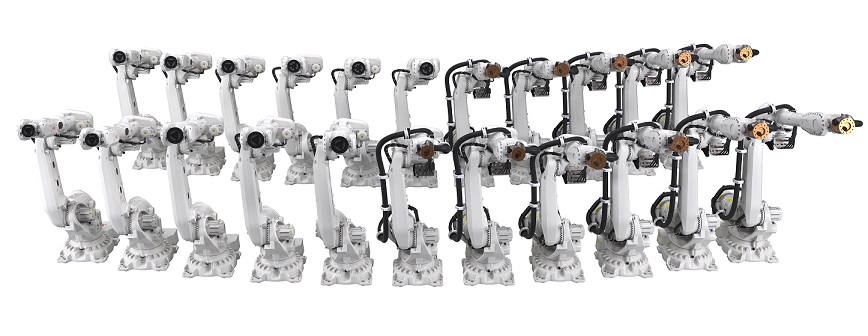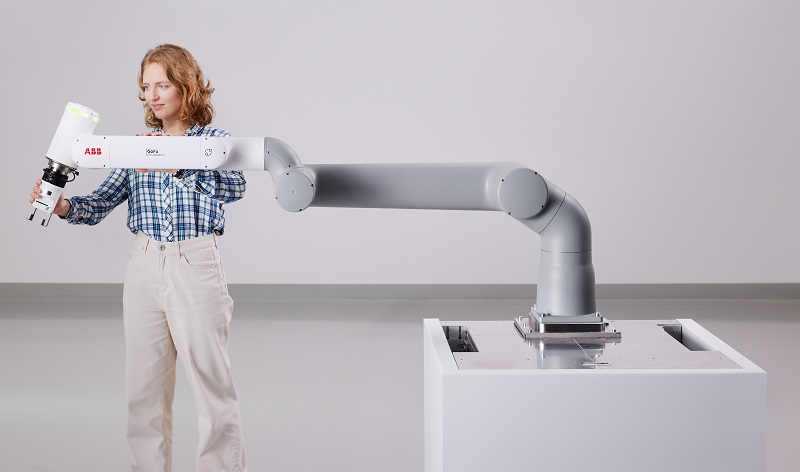ABB’s Newest Additions to the Robot and Cobot Families
ABB has added several new industrial and collaborative robots to its automation catalog, intended primarily to meet growing production demands in the automotive and electric vehicle (EV) markets.
ABB has recently expanded its robot offerings by adding two new collaborative robots (cobots) and four new industrial robots to the already popular product lines. All of these products have been designed to serve the automotive industry, including the booming electric vehicle (EV) industry. While the heavy lifting is performed by the new robots, other small, labor-intensive tasks can be performed by the cobots. The cobots are also commonly used as training tools for new programmers, automation engineers, and technicians.
Newest ABB Industrial Robots
ABB has added the IRB 6710, IRB 6720, IRB 6730, and IRB 6740 product lines. These newest robots have a maximum payload capacity of 150 kg to 300 kg, and have a maximum reach from 2.3 m to 3.2 meters, depending on the product line. All four product lines contain multiple size and payload variants, leading to 22 separate product models that can be tailored for specific purposes.

22 variants across four of the newest models of industrial robots by ABB. Image used courtesy of ABB
With an eye toward the automotive industry, these robots can perform assembly operations, such as spot welding, laser welding, gluing, screw and bolt tightening, spraying, machine tending, and parts handling. With their large payload capacities, they can handle the heavy parts found in the automotive and EV industries.
Perhaps one of the most appealing advantages to these new robots from ABB is that they use 20% less power than comparable robots. This is due to the OmniCore control system that reportedly reduces unnecessary movement and provides best-in-class movement control, with accuracy down to within 0.03 mm.
Newest ABB Cobots
Besides the larger robots, ABB has also released two new lines of cobots. The GoFa 10 and its big brother, the GoFa 12, are capable of handling 10 kg and 12 kg maximum payloads, respectively. Compared to other cobots in their class, they can reach 14% farther.

Cobots, like the GoFa 10 and GoFa 12, are designed to occupy the same spaces as the technicians who use them. Image used courtesy of ABB
Both of these cobots can perform some of the same tasks as the full-sized robots, with movements as accurate as within 0.02 mm. They are well-suited for use in packaging, palletizing, machine tending, grinding and polishing operations, and other such tasks. While the industrial bots manage the heavy lifting, the cobots can be used in smaller-scale tasks without the burden of cumbersome safety enclosures and dedicated floor space.
One of the key advantages of these two cobots is their ease of programming. ABB’s Wizard programming software is designed to upskill technicians and new automation engineers alike, making it easy to learn the fundamentals of motion control and robotics. Each cobot also features built-in FlexPendant and SafeMove apps that make robot motion safe and carefully controlled.
Robots: Greater Variety for More Diverse Tasks
ABB developed these new robots to assist in large assembly processes. By increasing the lifting capacity as well as the energy efficiency, they ensure a faster ROI and thus will find their way into many new manufacturing operations, as well as those which are making large capital improvements. Besides production tasks, the newest cobots will serve as an excellent training tool for automation engineers and technicians to learn how to program, as well as perform small inspection and assembly tasks.

 Facebook
Facebook Google
Google GitHub
GitHub Linkedin
Linkedin








